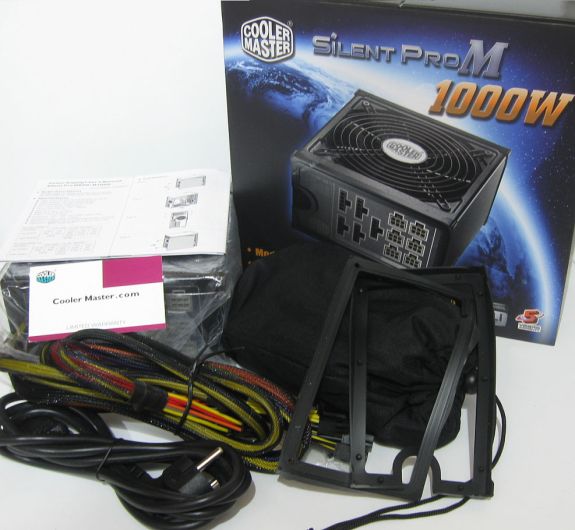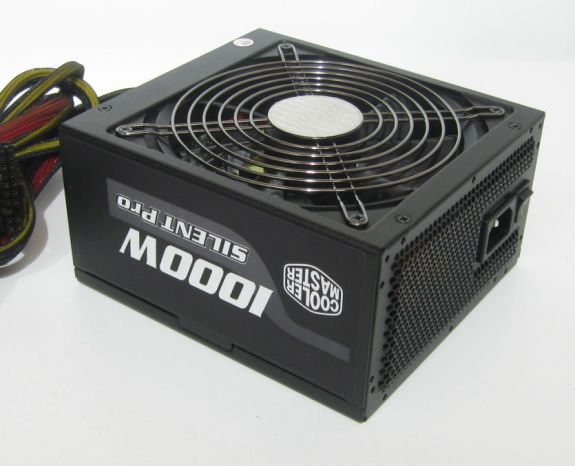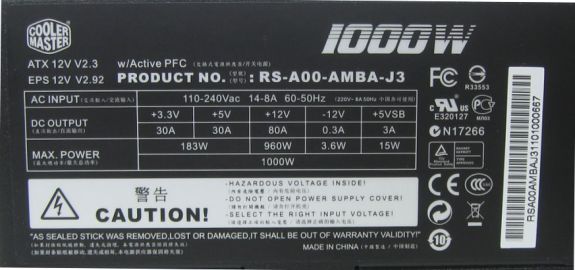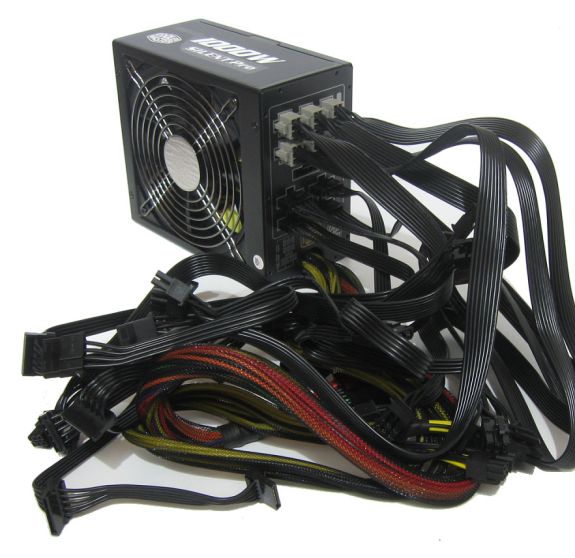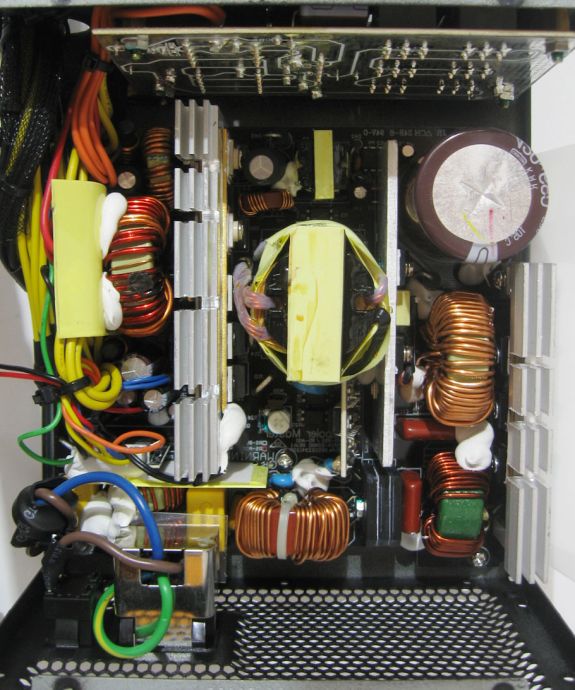
Original Link: https://www.anandtech.com/show/3856/cooler-master-silent-pro-m1000-1000w
Cooler Master Silent Pro M1000 1000W
by Martin Kaffei on September 5, 2010 10:30 PM EST- Posted in
- PSUs
- 80Plus
- Cases/Cooling/PSUs
- Cooler Master
- Silent Pro
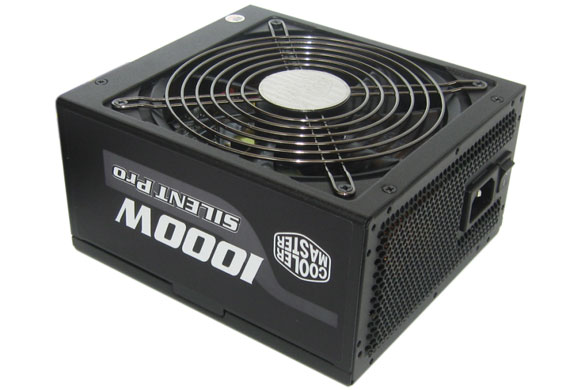
The Silent Pro series is one of the best-known series power supplies from Cooler Master, previously covering range from 500 to 700 watts. The range has now extended to 1000W with two models rated at 850W and 1000W, including flat connection cables found in higher power classes. Today we are looking at the latter. The 1000W model comes with a 5-year warranty, promises a maximum efficiency of 86%, and uses a single +12V rail. Excluding the motherboard connectors all cables are fully modular. Cooler Master also makes note of the high quality of selected components. Even though the housing of the PSU seems to be very similar to the smaller Silent Pro, a different ODM is responsible for the manufacture. On the next pages we will explore the design and topology and see if Cooler Master is able to keep their promises.
Features and Delivery Contents
The delivery content is very generous and includes the modular connectors in a separate bag. In addition to the power cord and a set of screws, two anti-vibration frames are also included, along with the standard installation manual. A small card points out that the product has to be registered online to get the full 5-year of warranty.
The ATX 2.3-PSU is "SLI Ready" as usual in this power class. As a special feature, Cooler Master wants to focus on the heat sinks. These are aluminium sheets complemented with copper plates (which increase the total volume of the heat sink) on the semiconductors. The copper should help dissipate the heat much better. The PSU dimensions are 150 (w) x 86 (h) x 165 (l) mm and Cooler Master promotes the single +12V rail and a Japanese electrolytic capacitor for filtering. The product homepage emphasizes the protection-IC and the flat cables as interesting features; the cables are the same as in preceding models.
Cooler Master puts a lot of its efforts into the case of the PSU. Even though the grey surface and the stylistically confident aesthetics are not really part of our review criteria, the robust powder coating and the thickness of the material are nice features. The casing in particular should help shield other devices from electromagnetic interference. The rear side with the small honeycombed ventilation holes is also very sturdy and doesn't show the flex typical in other power supplies on this area. A small power switch is right next to the AC-inlet. The Cooler Master logo is visible on one side as well as on the fan grill.
Like previously mentioned the Silent Pro uses a single +12V rail, rated at 80 amps and measured generously. The smaller +3.3V and +5V rails are specified at 30A each and should deliver 183 watts, which will be considered in our load tests.
Cables and Connectors
| Cables and Connectors | ||
| Fixed/Modular | Main | 24-pin 60 cm |
| ATX12V/EPS12V | 4+4-pin 65 cm | |
| PCIe | 6x 6/8-pin 50 cm (+2x2 6/8-pin 15cm) | |
| Peripheral | 3x PATA 40-70 cm / 3x PATA 40-70 cm + Floppy 15cm | |
| 2x SATA 50-60 cm / 3x SATA 50-80 cm / 4x SATA 50-80 cm | ||
Similar to the smaller models the fixed connectors (Main, ATX12V 4+4-pin) are sleeved rather cheaply. Apart from that there isn’t much reason for criticism. The flat connectors are supposed to add value to the PSU, even though they don't really improve the airflow in the case. Cooler Master disassociates the PCIe connectors (grey and wide) nicely from the peripheral connectors (black and narrow). On the homepage you can see the connector panel before buying the product. Even beginners should be able to connect the cables easily.
Six 6/8 pin- PCIe connectors can be expected on a 1KW unit, but because of the two Y-adapters eight connections can be used this way. If that’s an advantage you’ll have to judge from configuration to configuration. But it has to be put into consideration, that in case of using a Y-adapter two connectors are sharing a single cable cross-section. All other features are rather conventional. A floppy connector comes via an adapter. Nine SATA-connectors should be sufficient for most systems, but also the number of PATA connectors is acceptable.
Interior/Design
The distinctive protective foil on the input will clue some readersin: the electronics are manufactured by FSP. Notwithstanding the ODM, the configuration depends on what Cooler Master asks for, and this area shows some decent expenditures.
The EMI filtering consists of four Y- and four X-capacitors. Additionally two common mode chokes can be found, as well as a ferrite core, which is wrapped by phase and neutral cord. In contrast to many PSUs two linear chokes are used to compensate differential mode interferences. Not least we find an MOV. The power switch has been insulated with shrink tubing as it’s relatively close to the main PCB, but the highlight is neither the input-side filter nor the abundantly measured 680 µF filtering capacitor by Nippon-Chemicon (KMR, 105°C for 2000 hours until 20% of the capacity will be lost).
On the secondary circuit, where temperatures rise and space is scarce, high quality capacitors are used. We sometimes have discussed the usefulness of Japanese capacitors. When they are used sensibly in a high-end PSU, the choice will be a welcome one, and Cooler Master uses a good choice of Rubycon along with Nippon-Chemicon capacitors. This shows that Cooler Master doesn’t want to use the primary capacitor as an eye catcher and stint on the secondary side, but also uses high-grade parts there.
On +12V the Rubycon MBZ-series are used, which can be found on many motherboards but seem to harmonize quite well in power supplies. These are characterized by a low ESR (resistance), which resembles the losses in the capacitor. So low-ESR capacitors contribute their part to the general efficiency. On +3.3V and +5V mainly the YXG-model is used, which can take high ripple current and is specified for a lifespan of 6000 hours at 105°C. That are respectable qualities, which not only refer to these special components.
We often have pointed out that the weakest part limits the performance of the whole PSU and the quality of the capacitors is not the only feature that matters. The well-dimensioned rectifier bridges suit the well-dimensioned main capacitor and the EMI filtering suits the secondary setup. External as well as internal interferences are compensated by large filtering stages. Not least a Silicon Touch protection-IC is used, which offers OTP besides the usual functions and isn’t very common. Two measuring diodes check the temperature of the secondary heat sink and control the fan speed or shut down the PSU before the temperature gets too high.
But of course, good capacitors have their right to exist as well. Besides the quality, the number and presence of capacity is crucial to improving the voltage quality. On the cable management PCB, whose cables and connectors are soldered well, additional Nippon-Chemicon capacitors are smoothing the output voltage. We will see whether this can be noticed in our further measurements. The only point of criticism is a slightly loose PFC-choke as a point of hot glue was not set precisely enough.
Voltage Regulation
| +3.3V regulation | |
| Load | Voltage |
| 10% | 3.39V (+2.72%) |
| 20% | 3.38V (+2.42%) |
| 50% | 3.34V (+1.21%) |
| 80% | 3.30V (0%) |
| 100% | 3.27V (-0.90%) |
| 110% | 3.24V (-1.82%) |
| +5V regulation | |
| Load | Voltage |
| 10% | 5.10V (+2%) |
| 20% | 5.07V (+1.4%) |
| 50% | 4.99V (-0.2%) |
| 80% | 4.90V (-2%) |
| 100% | 4.84V (-3.2%) |
| 110% | 4.80V (-4%) |
| +12V regulation | |
| Load | Voltage |
| 10% | 12.09V (+0.75%) |
| 20% | 12.08V (+0.66%) |
| 50% | 12.05V (-+0.42%) |
| 80% | 12.00V (0%) |
| 100% | 11.97V (-0.25%) |
| 110% | 11,94V (-0,5%) |
+12V shows excellent regulation, while on the other voltages higher decreases can be noticed. However, all measurements are still in the range of specification. +5V drops to -4% at nearly 21A load, which is just within the specification. This is the weakest regulation in the test, as the +3.3V rail reaches 3.25V at similar load levels, but starts relatively high with 2.72 % (~2A). The 12V rail is really well balanced, because it never falls under -0.5% even at high load (up to 76A during the test). Even +5VSB stays on target at high loads and reaches 4.85V at minimum.
Efficiency and PFC
| 230VAC, 50Hz | ||
| Load | Efficiency | PFC |
| 10% | 81.95% | 0.892 |
| 20% | 86.49% | 0.959 |
| 50% | 87.03% | 0.975 |
| 80% | 86.40% | 0.980 |
| 100% | 84.38% | 0.981 |
| 110% | 83.29% | 0.981 |
| 115VAC, 60Hz | ||
| Load | Efficiency | PFC |
| 10% | 83.07% | 0.900 |
| 20% | 84.68% | 0.952 |
| 50% | 86.42% | 0.979 |
| 80% | 83.92% | 0.986 |
| 100% | 81.11% | 0.990 |
| 110% | 79.91% | 0.996 |
We have used the local mains voltage of 230V and 50 Hz as well as the American mains voltage of 115V and 60 Hz, where the efficiency is slightly lower but the power factor is slightly higher. On 230 VAC 82% efficiency are already reached at 10% load, where the earlier tested Seasonic X-Series 750W managed to achieve even higher efficiency. Even so Cooler Master keeps its promises as well, because it is only certified with 80Plus Bronze. The result at 115VAC is up to 86.42% efficiency, while at 230VAC 87% are reached.
On 230VAC the efficiency also retains on an acceptable level on 10% overload, while it drops faster below 85% on 115VAC and the Silent Pro completes this measurement with an efficiency of 79.91%. But at 115VAC it can excel with a high power factor, which never falls short of 0.90 and quickly rises up to 0.99. On 230VAC the rise is steeper and the PSU only catches up on higher loads. At its best it delivers a power factor of 0.981.
Cooling and Noise Level
| Sound Pressure Level | |
| Load | dB(A) |
| 10% | 20 |
| 20% | 20 |
| 50% | 20 |
| 80% | 22 |
| 100% | 30 |
| 110% | 35 |
Unfortunately the noise is one of our main points of criticism. The fan spins relatively fast, even at 50% load. In our opinion an additional regulating stage is missing, which falls short of 20dBA at 20% load. But the spin-up is moderate up to 80% load. Then the fan spins at nearly full speed and a noise level of 30dBA can be measured, climbing up to 35dBA at light overload, which is very loud.
On one hand the Silent Pro doesn't live up to its name. On the other hand FSP always has used rather conservative regulation of cooling to prevent overheating. When the customer is playing games or listening to music, he usually will not be able to discern a difference in noise, as the PSU will be drowned out by the noise of the latest high-end graphics cards. It is more annoying that the results in idle won't be better at all.
The Power Logic fan with the model number PLA14025S12H is a sleeve bearing type. It's a 135mm sized fan, with half of the cooling intake is blocked by an air guidance foil. Cooler Master tries to guide the down flowing air stream out through the ventilation holes, so no turbulence from additional down streaming air should occur near the EMI-filtering components. This sounds plausible in theory, but practically it is a massive restriction of the cooling potential of the fan. When such a large area is covered, it should be in question why such large fan is used at all. Cooler Master should cover the first third at most and use a better fan, which would be more suitable to the general quality of the electronics. But there are even louder PSUs in this class. It should be clear that especially here significantly more cooling power is required.
Ripple & Noise
| Ripple & Noise +3.3V | |
| Load | mV |
| 10% | 6.2 |
| 20% | 8.1 |
| 50% | 9.2 |
| 80% | 10.4 |
| 100% | 13.3 |
| 110% | 13.6 |
| Ripple & Noise +5V | |
| Load | mV |
| 10% | 10.5 |
| 20% | 12.2 |
| 50% | 13.3 |
| 80% | 16.2 |
| 100% | 21.6 |
| 110% | 22.5 |
| Ripple & Noise +12V | |
| Load | mV |
| 10% | 11.8 |
| 20% | 11.8 |
| 50% | 16.1 |
| 80% | 18.2 |
| 100% | 29.6 |
| 110% | 83.0 |
The presence of capacity mostly makes itself noticeable in the ripple results. +3.3V starts with a vanishingly low peak-peak value of just 6mV at 10% load, and later it increases to 14mV. +5 V begins with a higher result, but finishes with 23mV at overload, which is well within specification (50mV). On the +12V rail more capacitors are available for voltage straightening, but the currents are significantly higher. Here we have shown the worst case with a larger spike at 110% load at one of the measuring points. But this is still within specification and very decent, as it does not even reach 50% of the allowed level.
Conclusion
Cooler Master delivers a PSU that has appropriate features and worthy electronics for the intended market. The MSRP is moderately high at the moment, but online pricing is much better (see below). The cooling could be a lot quieter, especially considering the "Silent Pro" name, and the fan could be better as well, but most of the results in our load tests are decent.
The Silent Pro M1000 scores with its anti-vibration frames and an adequate number of PCIe connectors. A 5-year of warranty isn't out of the norm, especially because the product has to be registered online, but it's still better than some manufacturers. A lot depends on the quality of the service so the duration of warranty should not be the characteristic feature for purchase decisions.
The 60cm and 65cm lengths on the 24-pin and 4+4pin motherboard cables are very long, but we would have expected an additional 4-pin and 8-pin connector. Cooler Master strongly focuses on a high-end gaming PC with an 8-pin connector. But besides that there are motherboards and CPUs that need more than a single mainboard connector. In return, enough peripheral ports are present and the asynchronous array of SATA connectors considers a multitude of positions for hard drives and other peripherals. The floppy connector is realized by an adapter for those that still need such a device, which is a reasonable approach. The flat connection cables are beneficial as they are more flexible, but they offer no measurable advantage for airflow.
Inside the PSU the workmanship is satisfactory. Wherever needed, parts are insulated. The power supply is sensibly refined with a selected choice of components and only the PFC-choke could be affixed better. Otherwise the filtering stages are well equipped. This applies particularly to the capacitors as Cooler Master not only uses a good main capacitor, but good secondary ones as well. The manufacturer does not just look at details, but pays attention to the whole package. For example there are not only 105°C-capacitors used, but also with decent characteristics.
Nevertheless these are not the top-of-the-line components, which helps bring the price down to $164 online at the time of writing. Especially at low load the fan should be regulated in smaller steps, as the fan speed stays on the same level from 10% to 50% load. The sleeve bearing fan is a standard (i.e. mediocre) model, while most manufactures use their own specialized fans. Cooler Master surely could find a better fan from other suppliers.
Despite a few nitpicks, we can't criticize the measurement results. +5V ideally should not drop this far, but is still well within the range of the specification. In addition a modern system does not use the +5V rail to this extent and the drop was recorded at an overload situation. +3.3V drops no more than -1.5% and +12V is very constant as well. On the +12V rail the highest ripple spike was recorded, but overall the Silent Pro convinces. Even Enermax reaches nearly 60mV with their Pro/Modu87+, so the result is fine here. The competition is not that fierce in the matter of voltage quality. Especially at +3.3V and +5V single-digit or lower double-digit measurements are very hard to beat.
The efficiency (87 %) may not be the best, but is well within the promised level. Furthermore an efficiency of 82% at 10% load (scarcely 100w) is above the average level of previously tested power supplies. The power factor reaches 0.98 at 230VAC, which means minimal phase shifting. There isn't much missing to keep the M1000 from being the best ATX power supply in its price range, but unfortunately the PSU isn't very Silent (Pro).

